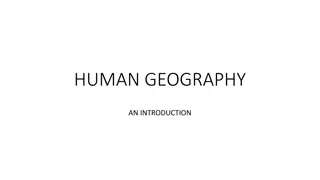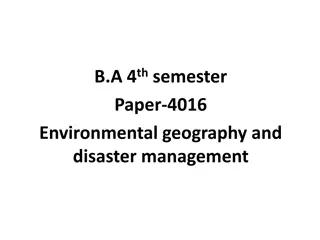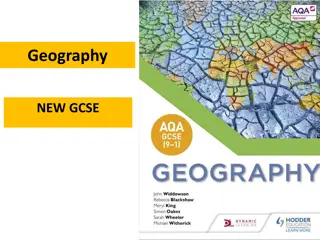Physical Geography: Branches and Concepts Explored
Physical geography is a field that studies natural processes on Earth's surface, providing the backdrop for human activities. It encompasses various branches like geomorphology, climatology, oceanography, biogeography, soil geography, and environmental geography. Geomorphology investigates landforms and surface processes, while climatology delves into atmospheric variations and climate conditions. These branches collectively analyze the interaction between human activities and the environment, shaping the world we live in.
Download Presentation

Please find below an Image/Link to download the presentation.
The content on the website is provided AS IS for your information and personal use only. It may not be sold, licensed, or shared on other websites without obtaining consent from the author.If you encounter any issues during the download, it is possible that the publisher has removed the file from their server.
You are allowed to download the files provided on this website for personal or commercial use, subject to the condition that they are used lawfully. All files are the property of their respective owners.
The content on the website is provided AS IS for your information and personal use only. It may not be sold, licensed, or shared on other websites without obtaining consent from the author.
E N D
Presentation Transcript
Name:- Sanjaykumar A Meanshi Head Department of Geography. Subject:-Physical Geography Seminar Top:- Branches of Physical Geography
geography (physical and human) that examines the natural processes occurring at the earth s surface that provide the physical setting for human activities. Physical geography differs from other sciences in that it focuses on the world around us from changes in daily weather conditions to landforms we travel every day. Physical geography is not only the agglomeration of different branches of earth and natural sciences like geomorphology, climatology, meteorology, pedology, geology etc. but it also studies the patterns of interactions between human environment. Physical geography can be defined differently as follows Physical geography is that branch of systematic activities and physical
1. Physical geography is the study of forces that influence the surface of earth. 2. Physical geography is to study natural phenomena. 3. Physical geography is the study of physical processes and patterns in the natural environment that shape the surface of the earth and their associated variability over space and time. 4. Physical geography studies the spatial patterns and spatial relationships of environmental components of the globe in regional context, it also studies the causes of regional patterns of such relationships.
Branches of Physical geography Geomorphology Climatology Oceanography Biogeography Soil geography Environmental geography
Geomorphology It is the science of earth surface processes and landforms. In other words it is the scientific study of surface involving interpretative description of landforms, their origin and development and nature and mechanism of geomorphological processes which evolve the landforms. Modern geomorphology also focuses on modeling landform shaping processes to predict both short-term (rapid) changes such as landslides, floods, coastal storm, erosion, and long term (slower) changes, such as soil erosion in agricultural areas or as a result of strip mining.
Climatology variability of atmospheric conditions (heat and moisture) over space and time. According to Critchfield, climatology is the science which studies the nature of climate, the causes and interpretation of its spatial variations and its association with the elements of natural environment and human activities. In simple words it is the systematic and regional study of atmospheric conditions i.e. weather and climate. Climatology is concerned with climate change, both in past and future Climatology is the science that describes and explains the
Oceanography The science of hydrosphere i.e. oceans and seas is called oceanography which includes the consideration, description and analysis of both physical and biological aspects of hydrosphere. It is concerned with the study of various types of Oceanic component and processes related to ocean floor depths, currents, corals reefs, and continental drifts etc. The study of oceanography has gained much importance during the current times because of the economic and strategic importance of oceans and seas. Today more focus is on applied oceanography which includes the consideration of delineation, mapping, exploration, utilization and management of marine abiotic as well as biotic resources.
Biogeography Biogeography is the science of the distributions of organisms at varying spatial and temporal scales, as well as the processes that produce these distribution patterns. Local distribution of plants and animals typically depend on the suitability of the habitat that supports them. In this application biogeography is closely aligned with ecology. Over broader scales and time periods, the migration, evolution and extinction of plants and animals are key processes that determine their spatial distribution patterns. Thus, bio-geographers often seek to reconstruct past patterns of plants and animal communities from fossil evidence of various kinds























